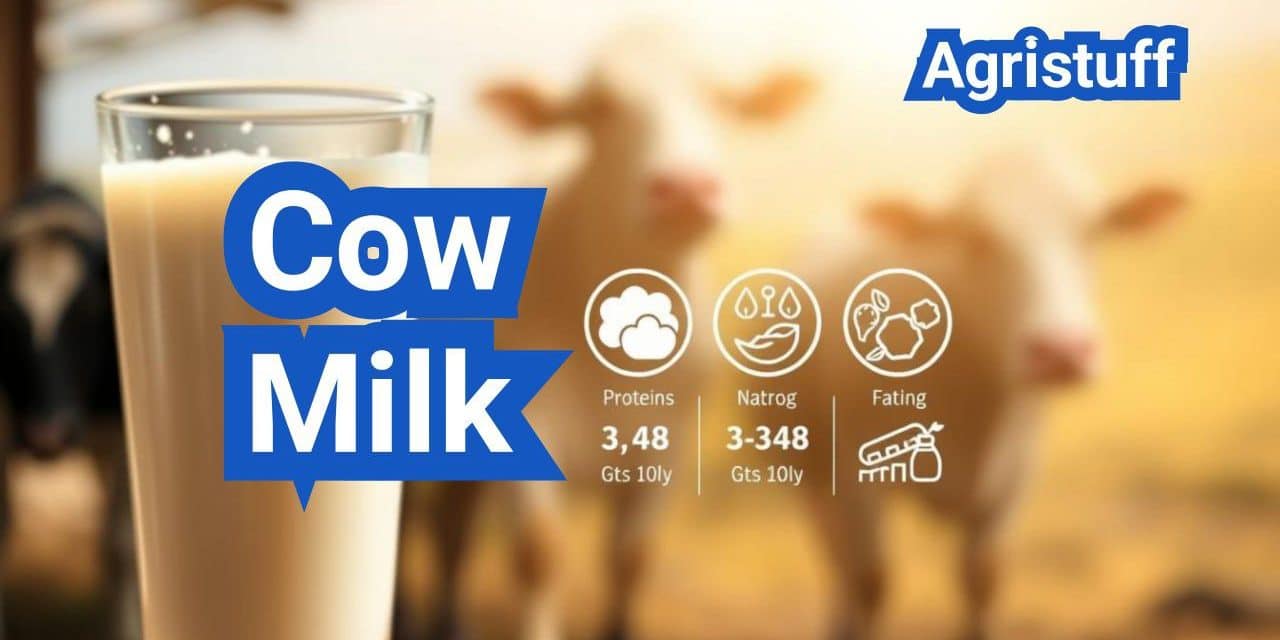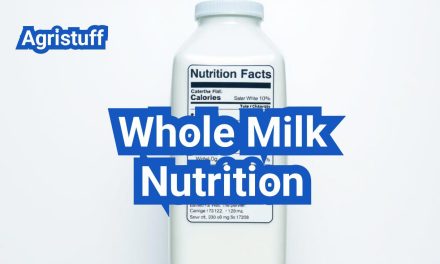Cow milk is a staple in many diets around the world, providing essential nutrients and serving multiple purposes in cooking and as a beverage.
Rich in proteins, fats, carbohydrates, vitamins, and minerals, cow milk is a nutrient-rich food that supports overall health. Its composition makes it a versatile ingredient in various recipes and a primary source of nutrition for many.
The standards for cow milk production ensure its quality and safety for consumption. With the help of modern cow milking machines, dairy farms can maintain high standards in milk production.
Key Takeaways
- Cow milk is rich in proteins, fats, carbohydrates, vitamins, and minerals.
- It serves multiple purposes in cooking and as a nutritious beverage.
- Cow milk composition and nutritional value make it a staple in many diets.
- Standards for cow milk production ensure its quality and safety.
- Cow milking machines help maintain high standards in dairy farming.
The Complete Nutritional Profile of Cow Milk
Cow milk is a nutrient-dense beverage, offering a broad spectrum of vitamins, minerals, and macronutrients. It is composed of about 87% water, with the remaining 13% consisting of various nutrients.
Macronutrients: Protein, Fat, and Carbohydrates
Cow milk contains a balanced mix of macronutrients. The protein content includes casein and whey proteins, which are high-quality proteins that provide essential amino acids. The fat content varies depending on the type of milk, with whole milk containing around 3.5% fat. Carbohydrates are primarily in the form of lactose, a disaccharide that serves as a vital energy source.
Essential Vitamins and Minerals
Cow milk is a rich source of several essential vitamins and minerals, including calcium, vitamin D, and vitamin B12. These nutrients play crucial roles in bone health, immune function, and the formation of red blood cells.
Calcium Content Per Cup
A cup of cow milk typically contains about 300 mg of calcium, making it an excellent source for supporting bone health and development.
Bioavailability of Nutrients
The nutrients in cow milk are highly bioavailable, meaning they are easily absorbed by the body. This high bioavailability enhances the nutritional benefits of consuming cow milk, supporting overall health and well-being.
Understanding Cow Milk Composition and Structure

Cow milk is a complex nutrient-rich beverage with a unique composition that contributes to its nutritional value. Its composition is crucial for understanding its nutritional benefits and various applications in food products.
Water Content and Solids Distribution
Cow milk is primarily composed of water, making up about 87% of its content. The remaining 13% consists of solids, including proteins, fats, carbohydrates, and minerals. The distribution of these solids is vital for the nutritional and functional properties of milk.
Milk Fat Globules and Structure
The fat content in cow milk is present in the form of milk fat globules, which are surrounded by a membrane. This structure is important for the digestibility and nutritional availability of milk fat. The size and distribution of these globules can vary, affecting the creaminess and texture of milk products.
Protein Types: Casein and Whey
Cow milk contains two main types of proteins: casein and whey. Casein is the predominant protein, making up about 80% of the total protein content, while whey protein accounts for the remaining 20%. Both proteins have distinct nutritional and functional properties, making them valuable for various applications.
Comparison of Casein and Whey Proteins
| Characteristics | Casein | Whey |
|---|---|---|
| Proportion | 80% | 20% |
| Digestion Rate | Slow | Fast |
| Nutritional Benefit | Sustained Release | Rapid Absorption |
Natural Enzymes and Bioactive Compounds
Cow milk also contains natural enzymes and bioactive compounds that contribute to its nutritional and health benefits. These compounds can enhance the immune system and support overall health. The presence of these bioactive elements makes cow milk a valuable component of a balanced diet.
“The nutritional complexity of cow milk, including its proteins, fats, and bioactive compounds, underscores its importance in human nutrition.”
Types of Cow Milk You Can Choose From
Cow milk is available in various forms to cater to different dietary needs and preferences. The main difference between these types is their fat content, which is adjusted through processing.
Whole Cow Milk (3.25% Fat)
Whole cow milk contains 3.25% fat, making it a rich source of energy. It is ideal for those who require higher calorie intake or prefer the taste and texture of full-fat milk.
Reduced-Fat Cow Milk (2%)
Reduced-fat cow milk, with 2% fat content, offers a compromise between whole milk and lower-fat options. It is suitable for those looking to reduce their fat intake while still enjoying the benefits of cow milk.
Low-Fat Cow Milk (1%)
Low-fat cow milk contains 1% fat, making it an even lighter option. It is a good choice for individuals monitoring their fat consumption.
Skim Milk (Fat-Free)
Skim milk, also known as fat-free milk, has almost all its fat removed. It is an excellent option for those on a very low-fat diet or managing calorie intake.
The different types of cow milk cater to various needs, from high-energy whole milk to fat-free skim milk. Consumers can choose based on their dietary requirements, taste preferences, or cooking needs.
- Whole cow milk: 3.25% fat, rich and creamy.
- Reduced-fat cow milk: 2% fat, a middle ground.
- Low-fat cow milk: 1% fat, for lower calorie intake.
- Skim milk: Fat-free, ideal for very low-fat diets.
Specialized Varieties of Cow Milk

Specialized cow milk varieties have gained popularity due to their distinct nutritional profiles and production methods. These varieties cater to different consumer needs, ranging from those seeking milk with specific protein structures to others looking for products produced under certain farming practices.
A1 vs A2 Cow Milk: What’s the Difference?
The distinction between A1 and A2 cow milk lies in the type of beta-casein protein present. A2 milk contains only the A2 type of beta-casein, which some research suggests may be easier to digest for people who experience discomfort after consuming conventional milk.
A1 vs A2 Milk: The debate centers around the potential health benefits of A2 milk over A1 milk, with some consumers reporting reduced digestive issues.
Organic and Grass-Fed Options
Organic cow milk comes from farms that adhere to organic farming standards, avoiding synthetic fertilizers and pesticides. Grass-fed cow milk is produced by cows that graze on grass rather than being grain-fed, potentially altering the milk’s fatty acid profile.
- Organic milk: Produced without synthetic additives.
- Grass-fed milk: May have a different fatty acid composition.
Vitamin D Fortified Cow Milk
Many dairy producers fortify their cow milk with Vitamin D to enhance its nutritional value. Vitamin D is crucial for bone health and immune function, making fortified milk a beneficial choice for consumers.
Importance of Vitamin D: It supports bone health and immune system function.
Raw Milk: Understanding the Risks
Raw cow milk is consumed without pasteurization. While some consumers prefer it for its perceived health benefits, it poses significant health risks due to the potential presence of harmful bacteria like E. coli and Salmonella.
“Consuming raw milk can pose serious health risks, including the potential for foodborne illnesses caused by pathogens such as E. coli and Salmonella.” – FDA Statement
Understanding these specialized varieties can help consumers make informed choices about their dairy consumption, aligning with their dietary needs and preferences.
How Cow Milk Is Processed for Safety
Cow milk processing involves several critical steps to ensure its safety for consumption. The primary goal of these processes is to eliminate harmful bacteria and extend the shelf life of milk.
Pasteurization Methods and Their Effects
Pasteurization is a crucial step in milk processing that involves heating the milk to a high temperature to kill harmful bacteria. There are different pasteurization methods, including High-Temperature Short-Time (HTST) and Extended Shelf Life (ESL) pasteurization. HTST involves heating milk to 161°F for at least 15 seconds, while ESL pasteurization heats milk to 134°F for at least 2 seconds.
The Homogenization Process Explained
Homogenization is another important step in milk processing that ensures the uniform distribution of fat molecules throughout the milk. This process involves forcing the milk through a small opening under high pressure, breaking down the fat molecules into smaller particles. As a result, homogenized cow milk has a consistent texture and flavor.
Ultra-High Temperature (UHT) Treatment
UHT treatment involves heating milk to a very high temperature (usually around 280°F) for a short period, followed by rapid cooling. This process extends the shelf life of milk by killing bacteria and other microorganisms. UHT-treated milk can be stored at room temperature until opened.
Farm-to-Table Journey of Milk
The journey of milk from farm to table involves several steps, including milking, storage, transportation, processing, packaging, and distribution. At each stage, milk is handled and treated to ensure its safety and quality. The following table summarizes the key steps in the farm-to-table journey of milk:
| Step | Description |
|---|---|
| Milking | Milk is extracted from cows using milking machines. |
| Storage | Milk is stored in cooled tanks on the farm. |
| Processing | Milk is pasteurized, homogenized, and packaged. |
| Distribution | Milk is transported to stores and supermarkets. |
In conclusion, cow milk processing involves several critical steps to ensure its safety and quality. By understanding these processes, consumers can appreciate the effort that goes into producing safe and nutritious milk.
Cow Milk Standards and Quality Regulations

Cow milk standards and quality regulations play a crucial role in maintaining its safety for public consumption. These regulations ensure that milk is produced, processed, and distributed in a manner that minimizes the risk of contamination and maintains nutritional quality.
FDA Standards for Commercial Milk
The FDA sets strict standards for commercial milk, including requirements for pasteurization, grading, and labeling. These standards help ensure that milk is safe for consumption and accurately represented to consumers.
USDA Grading System Explained
The USDA grading system evaluates milk based on factors such as bacterial count, temperature, and appearance. The grading system helps to differentiate between various qualities of milk, with Grade A being the highest standard for fluid milk.
| Grade | Bacterial Count | Temperature |
|---|---|---|
| Grade A | Less than 100,000 cfu/ml | Stored at 4°C or less |
| Grade B | Less than 300,000 cfu/ml | Stored at 4°C or less |
Organic Certification Requirements
Organic certification for cow milk involves adhering to specific production and processing standards, including the use of organic feed and avoidance of certain practices like the use of antibiotics.
Testing Protocols for Safety
Regular testing protocols are in place to ensure the safety of cow milk, including checks for bacterial contamination, antibiotics, and other contaminants.
How to Properly Store and Handle Cow Milk
To enjoy cow milk at its best, it’s essential to understand the right ways to store and handle it. Proper storage and handling practices not only maintain the milk’s quality but also ensure its safety for consumption.
Optimal Storage Temperature Guidelines
Cow milk should be stored in the refrigerator at a temperature below 40°F (4°C). This low temperature slows down the growth of bacteria and other pathogens, thereby extending the milk’s shelf life. It’s also important to keep the milk away from the refrigerator door, where the temperature can fluctuate more.
Container Selection and Best Practices
The container in which cow milk is stored can significantly impact its quality. Glass or plastic containers with tight-fitting lids are recommended. The container should be clean and dry before filling it with milk. Additionally, storing milk in its original container can help prevent contamination.
Shelf Life Expectations for Different Types
The shelf life of cow milk varies depending on its type and storage conditions. Generally, pasteurized cow milk can last up to a week when stored properly in the refrigerator. Ultra-pasteurized milk, on the other hand, can have a longer shelf life, often up to several weeks.
| Type of Cow Milk | Shelf Life (Refrigerated) |
|---|---|
| Pasteurized | Up to 7 days |
| Ultra-Pasteurized | Up to 30-90 days |
Identifying Signs of Spoilage
It’s crucial to be able to identify when cow milk has gone bad. Signs of spoilage include an off or sour smell, curdling, or an unusual texture. If the milk has been stored improperly or is past its expiration date, it’s best to err on the side of caution and discard it.
Health Benefits of Drinking Cow Milk
Drinking cow milk is associated with various health advantages due to its rich nutritional profile. Cow milk is a significant source of essential nutrients, including proteins, vitamins, and minerals that contribute to overall health.
Supporting Bone Health and Development
Cow milk is renowned for its role in supporting bone health, primarily due to its high calcium content. Calcium is crucial for the development and maintenance of strong bones and teeth. Regular consumption of cow milk can help prevent conditions like osteoporosis, particularly in older adults.
Muscle Recovery and Protein Utilization
The protein content in cow milk makes it an excellent beverage for muscle recovery after exercise. The proteins help in repairing and building muscle tissue, making cow milk a popular choice among athletes and individuals who engage in regular physical activity.
Immune System Support Functions
Cow milk contains various immune factors, including immunoglobulins and other bioactive compounds, that can support immune system function. These components help in protecting against infections and potentially reducing the severity of illnesses.
Potential Cardiovascular Benefits
Some studies suggest that moderate consumption of cow milk may have cardiovascular benefits, including helping to lower blood pressure and reduce the risk of heart disease. The potassium content in cow milk is believed to play a role in these benefits by counteracting the effects of sodium and promoting overall cardiovascular health.
| Nutrient | Benefit |
|---|---|
| Calcium | Supports bone health |
| Protein | Aids in muscle recovery |
| Potassium | Contributes to cardiovascular health |
Managing Cow Milk Allergies and Intolerances
Managing cow milk allergies and intolerances requires a comprehensive understanding of their symptoms and causes. These conditions can significantly impact an individual’s quality of life, making it essential to adopt appropriate management strategies.
Identifying Milk Allergy Symptoms
Cow milk allergy is an immune-mediated reaction to one of the proteins in cow milk, typically casein or whey. Symptoms can range from mild to severe and include hives, itching, swelling, stomach cramps, diarrhea, and in severe cases, anaphylaxis. Prompt identification and avoidance of cow milk products are crucial in managing milk allergy.
Lactose Intolerance: Causes and Solutions
Lactose intolerance occurs due to a deficiency in lactase, the enzyme that breaks down lactose, a sugar found in milk. Symptoms include bloating, gas, diarrhea, and stomach cramps after consuming lactose-containing products. Lactose-free cow milk options are available for those who still wish to consume dairy products without the discomfort.
| Condition | Symptoms | Management |
|---|---|---|
| Cow Milk Allergy | Hives, itching, swelling, stomach cramps, diarrhea, anaphylaxis | Avoidance of cow milk products |
| Lactose Intolerance | Bloating, gas, diarrhea, stomach cramps | Lactose-free products or lactase enzyme supplements |
Lactose-Free Cow Milk Options
Lactose-free cow milk is made by adding lactase to regular cow milk, breaking down the lactose into easily digestible sugars. This process allows individuals with lactose intolerance to consume cow milk without experiencing the usual symptoms.
When to Consult a Healthcare Provider
If symptoms persist or are severe, it is advisable to consult a healthcare provider for proper diagnosis and management. They can provide guidance on whether a milk allergy or lactose intolerance is present and recommend appropriate dietary adjustments.
Comparing Cow Milk to Alternative Options

Cow milk has been a staple in many diets for centuries, but how does it compare to newer plant-based milk alternatives and other dairy options like buffalo milk? As consumers become more informed about their dietary choices, understanding the differences between these options is crucial.
Cow Milk vs. Plant-Based Milk Alternatives
Plant-based milk alternatives, such as almond milk, soy milk, and oat milk, have gained popularity due to their perceived health benefits and environmental sustainability. However, their nutritional profiles vary significantly from cow milk. While cow milk is rich in protein, calcium, and vitamins D and B12, many plant-based milks are fortified with these nutrients to match the nutritional profile of dairy milk. For instance, a cup of cow milk contains about 8 grams of protein, whereas almond milk contains only about 1 gram per cup unless fortified.
When comparing cow milk to plant-based alternatives, it’s essential to consider the nutritional content, especially for individuals with specific dietary needs or restrictions. For example, those with dairy allergies or intolerances may prefer plant-based options, while athletes or individuals requiring high protein intake might prefer cow milk or fortified plant-based milks.
Nutritional Differences Between Cow and Buffalo Milk
Buffalo milk, another dairy option, has a different nutritional profile compared to cow milk. It contains higher levels of fat, protein, and calcium, making it a richer source of nutrients. Buffalo milk is often used to produce mozzarella cheese and other dairy products due to its creamy texture and rich flavor. However, its higher fat content may not be suitable for everyone, particularly those watching their calorie intake.
In contrast, cow milk is more widely available and has a lower fat content, especially when consumed as reduced-fat or skim milk. The choice between cow and buffalo milk depends on individual nutritional needs and preferences.
Cost-Benefit Analysis of Different Milk Types
The cost of milk varies significantly depending on the type and brand. Generally, cow milk is more affordable than buffalo milk and some premium plant-based milks. However, the cost-benefit analysis should consider not just the price but also the nutritional value and how well it meets individual dietary needs.
- Cow milk: Generally affordable, rich in protein and calcium
- Plant-based milks: Varying costs, may be fortified with nutrients, suitable for those with dairy allergies or intolerances
- Buffalo milk: Higher cost, richer in nutrients, often used for specific dairy products
Making the Right Choice for Your Needs
Ultimately, the choice between cow milk, plant-based milk alternatives, and buffalo milk depends on individual needs, dietary restrictions, and personal preferences. By considering the nutritional content, cost, and how well each option aligns with one’s lifestyle, consumers can make informed decisions that support their health and well-being.
Modern Cow Milking Processes and Technology

Cow milking has evolved from manual processes to sophisticated technological systems. The dairy industry has seen significant advancements in milking techniques, improving both efficiency and hygiene.
Evolution of Milking Techniques
Traditionally, milking was done manually, a process that was both time-consuming and labor-intensive. The introduction of cow milking machines revolutionized the industry by increasing efficiency and reducing labor costs.
How Cow Milking Machines Work
Cow milking machines simulate the natural sucking action of a calf, ensuring comfortable and efficient milking. These machines are equipped with sensors to monitor milk flow and detect any abnormalities, enhancing quality control during the milking process.
Robotic Milking Systems
Robotic milking systems represent the latest innovation in dairy farming. These systems allow cows to be milked voluntarily throughout the day, improving milk yield and reducing labor requirements. The robots are equipped with advanced sensors and cleaning systems to maintain hygiene.
Quality Control During Collection
Quality control is paramount during milk collection. Modern milking systems are equipped with sensors to monitor milk quality, detecting any contaminants or abnormalities. The milk is then cooled immediately to preserve its quality.
| Milking System | Key Features | Benefits |
|---|---|---|
| Cow Milking Machines | Simulates calf’s sucking action, sensors for milk flow | Increased efficiency, improved hygiene |
| Robotic Milking Systems | Voluntary milking, advanced sensors, automated cleaning | Improved milk yield, reduced labor |
How to Use Cow Milk in Cooking and Baking

Cow milk is a versatile ingredient that can elevate a variety of dishes, from savory meals to sweet baked goods. Its rich nutritional profile and culinary adaptability make it a staple in many kitchens.
Selecting the Right Milk Type for Different Recipes
Choosing the appropriate type of cow milk can significantly impact the outcome of your recipes. For instance, whole milk is ideal for creamy sauces and desserts, while skim milk is better suited for lower-fat recipes. Reduced-fat milk offers a compromise between the two, making it a versatile option for various dishes.
Creating Sauces, Soups, and Custards
Cow milk is a fundamental component in many sauces, soups, and custards. It adds a creamy texture and richness that enhances the overall flavor. To make a classic béchamel sauce, for example, you can combine milk with butter and flour, then season with nutmeg and salt. As Julia Child once said, “The only time to eat diet food is while you’re waiting for the steak to cook.” This emphasizes the indulgent role milk plays in cooking.
Baking Applications and Substitutions
In baking, cow milk can be used in various forms, from whole milk to buttermilk. Buttermilk, for instance, adds a tangy flavor and tenderness to baked goods like cakes and biscuits. You can make a substitute for buttermilk by mixing milk with vinegar or lemon juice, creating a versatile ingredient for many recipes.
Making Homemade Dairy Products
Cow milk is not just for direct consumption or use in recipes; it can also be transformed into various dairy products. You can make yogurt by heating milk and adding a yogurt culture, or create cheese by curdling milk with rennet. These homemade dairy products can be customized to suit your taste preferences and dietary needs.
By understanding the different uses of cow milk in cooking and baking, you can unlock a world of culinary possibilities. Whether you’re making a simple sauce or crafting homemade dairy products, cow milk is an indispensable ingredient.
Cow Milk Recommendations for Different Age Groups

Understanding the appropriate cow milk consumption levels for different age groups is crucial for maximizing its health benefits. Cow milk is rich in nutrients such as calcium, protein, and vitamins D and B12, making it a valuable component of a balanced diet.
Guidelines for Infants and Young Children
For infants under 12 months, breast milk is the primary source of nutrition. However, cow milk can be introduced around 12 months as a supplement. Whole cow milk is recommended for children aged 1-2 years due to its fat content, which is essential for brain development. Children under 2 years should not consume reduced-fat or skim milk unless advised by a healthcare provider.
Optimal Intake for Adolescents and Adults
Adolescents require adequate calcium and protein for bone growth and development. Two to three cups of cow milk per day can help meet these needs. Adults can benefit from cow milk as well, with one cup per day being sufficient for maintaining bone health. The choice between whole, low-fat, or skim milk depends on individual calorie needs and dietary preferences.
Considerations for Elderly Consumers
Elderly individuals may need to adjust their cow milk consumption based on their overall diet and health status. Those with osteoporosis or at risk of bone fractures may benefit from higher calcium intake through cow milk. However, individuals with lactose intolerance or dairy allergies need to consider alternatives or lactose-free options.
Adjusting Consumption Based on Health Needs
Health conditions such as high cholesterol or calorie concerns may necessitate choosing reduced-fat or skim milk. Additionally, individuals with dairy intolerance can opt for lactose-free cow milk. It’s essential to consult healthcare providers for personalized dietary recommendations.
| Age Group | Recommended Cow Milk Consumption | Considerations |
|---|---|---|
| Infants (0-12 months) | Not recommended as primary nutrition | Breast milk is primary |
| Young Children (1-2 years) | Whole cow milk | Fat content is crucial for development |
| Adolescents | 2-3 cups/day | Supports bone growth |
| Adults | 1 cup/day | Maintains bone health |
| Elderly | Varies based on health | Consider osteoporosis risk and lactose tolerance |
Cow milk can be a nutritious addition to the diet across various age groups when consumed appropriately. Understanding individual nutritional needs and health conditions is key to maximizing its benefits.
Is Cow Milk Good for Specific Health Conditions?
Understanding the effects of cow milk on different health conditions is crucial for making informed dietary choices. Cow milk is rich in nutrients, including proteins, calcium, and vitamins, which can have varying impacts on health depending on the condition and individual needs.
Heart Patients and Cardiovascular Considerations
Cow milk contains saturated fats, which have been linked to heart health concerns. However, full-fat dairy consumption is not entirely associated with increased cardiovascular risk. Some studies suggest that moderate consumption of full-fat dairy may not significantly impact cardiovascular health for most people.
“The relationship between dairy fat intake and cardiovascular disease risk is complex and may depend on the overall dietary pattern.”
A study published in the Journal of the American Heart Association found that moderate dairy consumption, as part of a balanced diet, did not significantly increase the risk of cardiovascular disease.
| Dairy Type | Saturated Fat Content | Cardiovascular Impact |
|---|---|---|
| Whole Milk | High | Moderate Risk |
| Low-Fat Milk | Low | Lower Risk |
| Skim Milk | Very Low | Lowest Risk |
Diabetes Management and Milk Consumption
Cow milk can be part of a diabetes management diet due to its protein and fat content, which can help regulate blood sugar levels. Low-fat or skim milk is often recommended as it has a lower calorie and saturated fat content.
A study in the American Journal of Clinical Nutrition found that dairy consumption, particularly low-fat dairy, was associated with a reduced risk of type 2 diabetes.
Weight Management Perspectives
Cow milk can aid in weight management due to its high protein content, which helps in satiety and muscle maintenance. Choosing the right type of milk is crucial; low-fat or skim milk is generally preferred for those watching their weight.
Research published in the Journal of the Academy of Nutrition and Dietetics suggested that dairy consumption, as part of a calorie-controlled diet, can support weight loss efforts.
Sports Nutrition Applications
Cow milk is a popular choice among athletes due to its high-quality protein content, which supports muscle recovery and growth. The carbohydrates in milk also help replenish energy stores post-exercise.
A study in the Journal of Agricultural and Food Chemistry found that cow milk protein was effective in promoting muscle protein synthesis after exercise, aiding in recovery.
Making Informed Choices About Cow Milk
Cow milk is a complex and nutrient-rich beverage that offers numerous health benefits when consumed as part of a balanced diet. By understanding its composition, nutritional profile, and potential drawbacks, consumers can make informed choices about their cow milk consumption.
The various types of cow milk, processing methods, and quality regulations discussed in this article highlight the importance of considering individual needs and health considerations when selecting a type of cow milk. Whether you’re looking to support bone health, manage allergies, or simply make a nutritious addition to your diet, cow milk can be a valuable choice.
Ultimately, making informed choices about cow milk involves being aware of its many facets, from nutritional content to production processes. By doing so, consumers can harness the benefits of cow milk while minimizing potential risks, ensuring a healthy and balanced lifestyle.
FAQ
What is the nutritional profile of cow milk?
Cow milk is a rich source of macronutrients, including protein, fat, and carbohydrates, as well as essential vitamins and minerals like calcium, vitamin D, and potassium.
What is the difference between whole, reduced-fat, low-fat, and skim cow milk?
The main difference lies in their fat content: whole milk contains 3.25% fat, reduced-fat milk contains 2%, low-fat milk contains 1%, and skim milk is fat-free.
What is A1 and A2 cow milk, and how do they differ?
A1 and A2 milk refer to the type of beta-casein protein present in the milk. A2 milk is considered a more easily digestible option for some individuals, as it contains only the A2 type of beta-casein.
Is raw cow milk safe to consume?
Raw cow milk can pose health risks due to the potential presence of pathogens like E. coli and Salmonella. Pasteurization is recommended to ensure safety.
How should cow milk be stored and handled?
Cow milk should be stored in the refrigerator at a temperature below 40°F (4°C) and consumed within a certain timeframe (usually 7-10 days). It should be kept in a tightly sealed container to prevent contamination.
Can cow milk be used in cooking and baking?
Yes, cow milk is a versatile ingredient used in various recipes, including sauces, soups, custards, baked goods, and homemade dairy products.
Is cow milk suitable for individuals with dairy allergies or intolerances?
Individuals with dairy allergies or intolerances may need to avoid cow milk or opt for lactose-free or alternative milk options. Consulting a healthcare provider is recommended.
How does cow milk compare to plant-based milk alternatives?
Cow milk and plant-based milk alternatives have different nutritional profiles, with cow milk generally being higher in protein and certain micronutrients. The choice between them depends on individual needs and preferences.
Can cow milk be beneficial for specific health conditions?
Cow milk may be beneficial for certain health conditions, such as supporting bone health, aiding muscle recovery, and potentially providing cardiovascular benefits. However, individual circumstances and health needs should be considered.
What are the benefits of organic and grass-fed cow milk?
Organic and grass-fed cow milk may offer benefits like higher levels of certain nutrients and more favorable fatty acid profiles. However, the nutritional differences can vary depending on factors like the cow’s diet and breed.
How is cow milk processed for safety?
Cow milk is processed through techniques like pasteurization, homogenization, and UHT treatment to ensure safety and extend shelf life.
What are the standards and regulations governing cow milk?
Cow milk is subject to various standards and regulations, including FDA standards, USDA grading, and organic certification requirements, to ensure quality and safety.
Conclusion of: Cow Milk
Cow milk: what it is and why it still matters
Cow milk is the lacteal secretion from healthy cows, and in the U.S. it remains a foundational food thanks to its reliable nutrition, strict safety standards, and wide availability. For Americans looking to build balanced meals, cow milk contributes high-quality protein, calcium, potassium, and—when fortified—vitamin D, all of which support bones, muscles, and overall health. It’s also one of the most standardized foods in the grocery aisle, which means the carton you buy in Maine will meet the same federal identity and safety rules as the one in California. Dietary Guidelines: dairy as a calcium source
Cow milk and your daily pattern in the USA
Most U.S. eating patterns that include cow milk aim for about three “cup-equivalents” of dairy per day for teens and adults, folded into meals like breakfast cereal, smoothies, soups, and sauces. That guidance exists because cow milk and other dairy foods efficiently deliver nutrients many Americans under-consume, notably calcium and vitamin D (often added), plus potassium. If you’re assembling a MyPlate-style plate, cow milk can cover the dairy group while fruits, vegetables, grains, and protein foods round out the rest. MyPlate dairy overview (UVA)
Cow milk composition at a glance
At a basic level, cow milk is a mixture of water, lactose (milk sugar), milk fat, and high-quality proteins (casein and whey) suspended with minerals and vitamins. A typical cup of cow milk provides roughly 300 mg of calcium along with complete protein that contains all essential amino acids—one reason athletes, kids, and older adults often include cow milk in meals and snacks. Exact calories and macros vary by fat level (whole vs. low-fat), but the calcium per cup stays close to that ~300 mg mark. NIH ODS: calcium & milk
Vitamins and minerals in cow milk
Beyond calcium, cow milk contributes potassium (helpful for blood pressure), vitamin B12 (for blood and nerve health), riboflavin (energy metabolism), phosphorus (bone structure), and, when fortified, vitamin D (calcium absorption). Because these nutrients work together, regularly including cow milk can make it simpler to meet daily targets without supplements. If you skip dairy, plan alternative sources or fortified options to cover the same nutrients that cow milk normally supplies. DGA: nutrients from dairy
How U.S. law defines cow milk
Unlike many foods, cow milk has a federal “standard of identity.” By law, beverage milk must be pasteurized or ultra-pasteurized and must contain at least 3.25% milkfat and ≥8.25% milk solids-non-fat to be sold as “milk.” Those thresholds create a predictable product profile—when you pour cow milk at home, you know what you’re getting. 21 CFR §131.110 (Milk)
Whole, 2%, 1%, and fat-free: what the names on cow milk mean
Carton names describe milkfat: whole cow milk is about 3.25% fat by weight; “reduced-fat” is 2%; “low-fat” is 1%; and “fat-free/skim” is essentially 0% fat (not more than 0.5% by weight under legacy rules). U.S. standards also address fortification: low-fat styles must contain added vitamin A to be nutritionally equivalent to whole, while vitamin D addition is optional but common across all types. 21 CFR §131.135 (Lowfat milk)
Pasteurization: the key safety step for cow milk
Pasteurization heats cow milk for a defined time and temperature to inactivate disease-causing microbes while preserving taste and nutrition. The national standard for Grade “A” milk is set through the FDA/US PHS Pasteurized Milk Ordinance (PMO), which states accepted time/temperature combinations (for example, High-Temperature Short-Time). Pasteurization is why commercially sold cow milk has a strong safety record in the U.S. FDA/USPHS PMO (2023)
Homogenization and the texture of cow milk
Homogenization is a mechanical process that breaks down fat globules so cream doesn’t rise, giving cow milk its smooth, uniform texture. While homogenization isn’t required by law, U.S. standards do recognize it, and most retail cow milk is homogenized for consistent mouthfeel and appearance that holds up in coffee, sauces, and cereals. Federal milk standard (homogenization noted)
Fortification: why vitamins A and D appear on cow milk labels
Because fat carries vitamin A naturally, removing fat lowers vitamin A content. U.S. standards therefore require adding vitamin A to low-fat and fat-free cow milk to restore “nutritional equivalence,” while vitamin D addition is optional (but common) for all milks. That’s why nutrition panels look similar across fat levels, even as calories and fat change. Vitamin A requirement for low-fat milk
Raw vs. pasteurized cow milk: what health agencies advise
Some consumers seek out unpasteurized (raw) cow milk, but public-health authorities warn it can carry pathogens such as Campylobacter, E. coli, Listeria, Salmonella, and more. Children, pregnant people, older adults, and the immunocompromised face higher risks of severe illness. Pasteurization sharply reduces these risks without making cow milk “ultra-processed.” CDC: Raw milk risks
Lactose intolerance vs. milk allergy: two different issues with cow milk
Lactose intolerance is a digestive limitation (low lactase enzyme) that can cause gas, bloating, or diarrhea after drinking cow milk; many people manage it by choosing lactose-free milk or smaller portions. By contrast, cow milk allergy is an immune reaction to milk proteins that can be serious and requires strict avoidance under medical guidance. Understanding which one applies matters for safe choices with cow milk. MedlinePlus: Lactose intolerance
When cow milk allergy is the concern
Clinically diagnosed cow milk allergy can cause hives, vomiting, and in rare cases anaphylaxis; pediatric allergists often see it in infancy, and many—but not all—children outgrow it. Anyone with suspected reactions to cow milk should seek evaluation and carry emergency medicine if prescribed. ACAAI: Milk allergy overview
Milk quality metrics: why somatic cell counts matter in cow milk
On farms and at plants, regulators track bulk-tank somatic cell count (SCC)—a proxy for udder health and milk quality. In the U.S., the federal legal maximum for Grade “A” cow milk shipments is 750,000 cells/mL, and repeated exceedances trigger regulatory action. Many herds run far below that threshold to meet quality goals and export requirements. USDA APHIS: SCC factsheet
Microbial standards that keep cow milk safe
Beyond SCC, regulators monitor standard plate counts (bacterial load) and coliforms before and after pasteurization. For example, Grade “A” raw cow milk for pasteurization is limited to 100,000 bacteria/mL, and pasteurized milk has tight post-process limits, supporting shelf life and safety when cold-held. CDFA: Milk standards summary
Labeling notes about cow milk: rBST statements and plant-based comparisons
You may see “from cows not treated with rBST” on cow milk cartons. FDA’s long-standing position is that milk from treated and untreated cows is not significantly different; labels that claim “no rBST” should pair that with a qualifying statement to avoid implying a safety advantage. Separately, FDA has issued guidance so plant-based “milk” alternatives use clear labeling and voluntary nutrient statements that help shoppers compare to cow milk. FDA Federal Register on rBST labeling
Buying and storing cow milk safely at home
At home, keep cow milk cold: the federal recommendation is at or below 40°F (4°C). Return milk to the fridge quickly, store it in the main compartment (not the door), and close the cap to limit flavor pickup. If your fridge rose above 40°F for more than two hours, many perishable foods—including cow milk—should be discarded. FDA: Refrigerator temperature guidance
How long does cow milk last?
Date labels are about quality, not safety; pasteurized cow milk typically keeps several days past “sell-by” when properly refrigerated, but follow odor, taste, and trusted storage charts. For a quick reference, federal consumer guidance provides conservative cold-storage timelines for many foods, including milk. FoodSafety.gov: Cold storage chart
Everyday kitchen uses for cow milk
Cooks rely on cow milk to add body to sauces, tenderness to baked goods, and creaminess to custards and soups—the proteins stabilize textures while lactose aids browning. Choosing whole cow milk yields richer results; using low-fat versions lightens calories while maintaining performance. For smoothies and cereal, any fat level of cow milk works; select based on taste and dietary goals. DGA: dairy in healthy patterns
Who benefits most from cow milk—and how to choose
Children, teens, pregnant people, and older adults often benefit from the calcium, protein, and (if fortified) vitamin D that cow milk delivers. Athletes may value cow milk’s high-quality protein for recovery, and those managing weight can pick lower-fat cow milk to trim calories. If you’re lactose intolerant, lactose-free cow milk provides the same nutrients without the symptoms. MedlinePlus: managing lactose intolerance
Final thought
Backed by clear federal standards and a century of food-safety practice, cow milk remains one of the most consistent, nutrient-dense staples in the U.S. food supply. Whether you prefer whole for flavor or low-fat for calorie goals—or need lactose-free—you can count on cow milk to fit a wide range of everyday uses, from breakfasts to baking, while meeting rigorous identity and safety benchmarks. DietaryGuidelines.gov
Sources & References
- 21 CFR §131.110 — Milk (eCFR)
- 21 CFR §131.135 — Lowfat milk (GovInfo PDF)
- FDA/USPHS Grade “A” Pasteurized Milk Ordinance (2023)
- CDC — Raw Milk: Risks and Germs
- FDA — Refrigerator Thermometers & Cold Facts
- FoodSafety.gov — Cold Food Storage Chart
- USDA APHIS — Bulk-Tank Somatic Cell Count (SCC) Factsheet
- CDFA — Milk Standards (counts & limits)
- DietaryGuidelines.gov — Food Sources of Calcium (dairy group)
- MedlinePlus — Lactose Intolerance
- ACAAI — Milk Allergy (patient resource)










